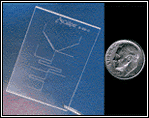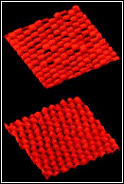
|

|
Many of the important lab procedures for performing chemical analysis have not changed much over the past 30 years and will probably remain functional for the next thirty. What has changed recently, however, is the pace and place at which some analyses can take place. Caliper Technologies of Palo Alto, California is an industry leader in the development of microscopic "lab equipment" that can perform complex chemical-analysis functions on the surface of semiconductors a chemistry lab on a microchip. The company has combined semiconductor engineering techniques with expertise on fluid dynamics to construct microstructures capable of the fluid-manipulation tasks necessary for analysis procedures including measuring, dispensing, mixing, separating, and detecting a wide variety of organic and inorganic chemicals. Electric forces serve as pumps and valves to guide liquids (in quantities as small as 10 million-millionths of a liter) through the appropriate channels and reservoirs. Caliper calls its implementation of the technology LabChip. LabChip enables several capabilities that researchers have never had before. It effectively miniaturizes all the lab equipment necessary to perform an analysis allowing users to perform the analysis on location. (Anyone care to calculate the expense in time and money of handling, shipping, and processing medical lab work?) Although the number of procedures amenable to the process is not yet large, LabChip does present a trend toward real-time, decentralized, less-expensive disease management. LabChip will also dramatically increase throughput for R&D efforts in biochemical research in areas such as drug screening, genomics, and combinatorial chemistry. Caliper is already working with Hoffmann-LaRoche on a chip for screening pharmaceutical compounds. Caliper has had to use or develop some fairly innovative technologies to create the LabChip including the electrical systems that move the fluids; micro-contact printing technology (less expensive than photolithography); techniques for mixing, separating, isolating, and detecting small amounts of fluids; and new manufacturing technologies for inexpensive materials such as glass and plastic.
For more information Variations on the basic techniques involved in scanning tunneling microscopy (developed in 1981) are rapidly bringing micron-level imaging techniques to a variety of industries. These microscopes construct computer images using data generated as a tiny probe travels across the surface of a sample. The new implementations generate the necessary data using any of a variety of physical effects including magnetic and electrical fields and effects (capacitance, conductance, inductance) or surface effects such as friction. Magnetic-resonance-force microscopes use the magnetic resonance of electron spins to produce atomic-scale three dimensional images. The new techniques and devices are seeing increasing use because of the decreasing cost of basic components such as computers, precision stages, lasers, and photodetectors. In addition, some of the new devices operate in ambient conditions early electron microscopes required a high vacuum. The more affordable machines are finding applications in biological and life sciences, semiconductor fabrication, analysis of electronic components, material sciences, and analysis of computer data storage devices. The U.S. National Institute of Standards and Technology is using a magnetic-resonance-force microscope to study the structure of chemical bonds. Researchers at Lawrence Berkeley National Laboratory hope to image the complex surface of molecules on the outside of cells by coating the tip of probes with self-assembled organic molecular films that can detect friction and lubrication effects on an atomic level. A joint project involving researchers at the University of California-Santa Barbara, the University of Tokyo, and Hughes Research Labs are using a probe that radiates terahertz electromagnetic fields to study a submicron-sized gallium arsenide resonant tunneling diode. The decreasing cost of the technology means it is becoming increasingly cost effective for commercial applications and several companies, including Park Scientific Instruments, Topometrix, and Digital Instruments are responding to the new market demand. Park Scientific provides a thorough explanation of its technology (complete with technical diagrams) at its Web site with A Practical Guide to Scanning Scope Microscopy. And Digital Instruments has a nice Theater of images at its site.
For more information Researchers at the Tokyo Institute of Technology and Keio University in Yokohama have filmed a natural, single-molecule motor in action as it twirled a long fiber of actin that the researchers attached to the unit's rotor. F1-ATPase is an enzyme that is a subunit of the enzyme ATP synthase, which plays an important role in the production of energy by mitochondria, the energy-producing organelles in cells. The researchers secured one end of the F1-ATPase to a glass slide and attached a fluorescent actin fiber 100 times the length of the enzyme to the other end of the enzyme. When they bathed the device in ATP molecules, the F1-ATPase started breaking down the ATP energy molecules and started spinning the actin filament in the process. Researchers had previously identified a variety of linear molecular motors but this is the first molecule they've confirmed as exhibiting a rotary drive mechanism. The central rotor is approximately 1 nanometer in diameter and rotates in a stator barrel that is approximately 5 nanometers wide. The molecular motor demonstrated a fair amount of torque by rotating a filament that is 100 times the motor's length. F1-ATPase is one-tenth the size of the biological devices that drive bacterial flagella, which were previously the smallest known natural motors. Next on the agenda for the Tokyo researchers? They plan to attach a plastic bead to the enzyme's drive shaft and then attach the enzyme itself to a bacterial flagellum to create a "moving toy". Have fun, folks. By the way, in case you've got plans for F1-ATPase, its drive shaft spins in a counter-clockwise direction.
For more information |
needtoknow said: Some companies are experimenting with combining changing price lists with corporate email showing customer/prospect requests. They could also be combined with projects up for bid from publications like Commerce Business Daily (for government projects) and onsale.com and other Web-based transactional services. Most Active Topics: Topic 1 Conference Business Topic 3 Conference Introductions Topic 23 Pliny Fisk's Resource Tracking DB | |||||
| ||||||
Also in Tech Scan: Learning and Cognition Chemistry Lab on a Microchip DNA Arrays | ||||||



